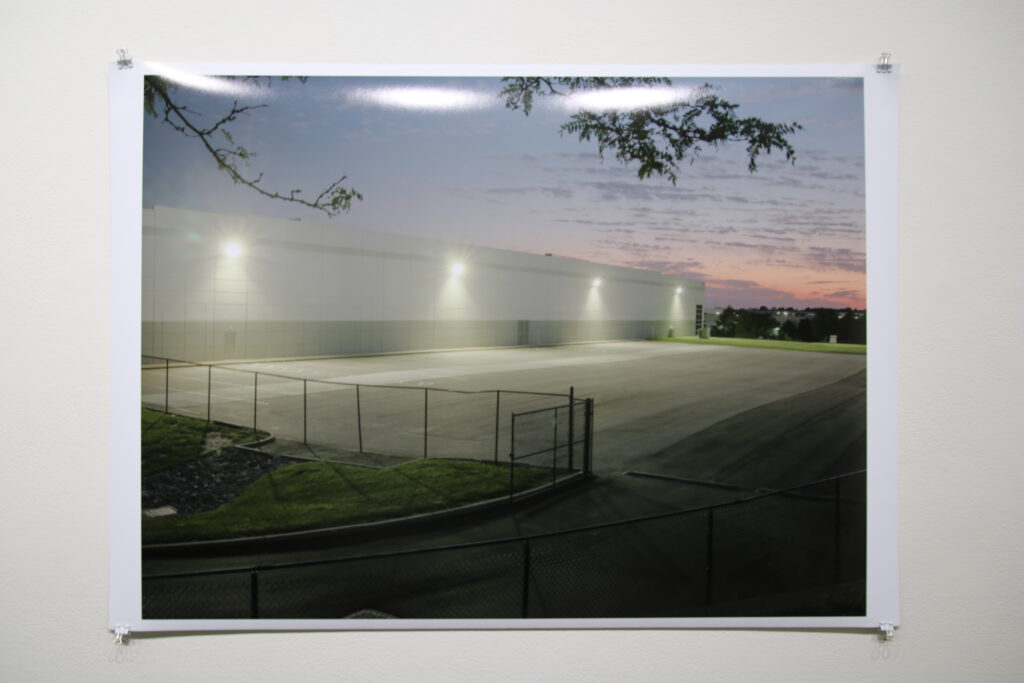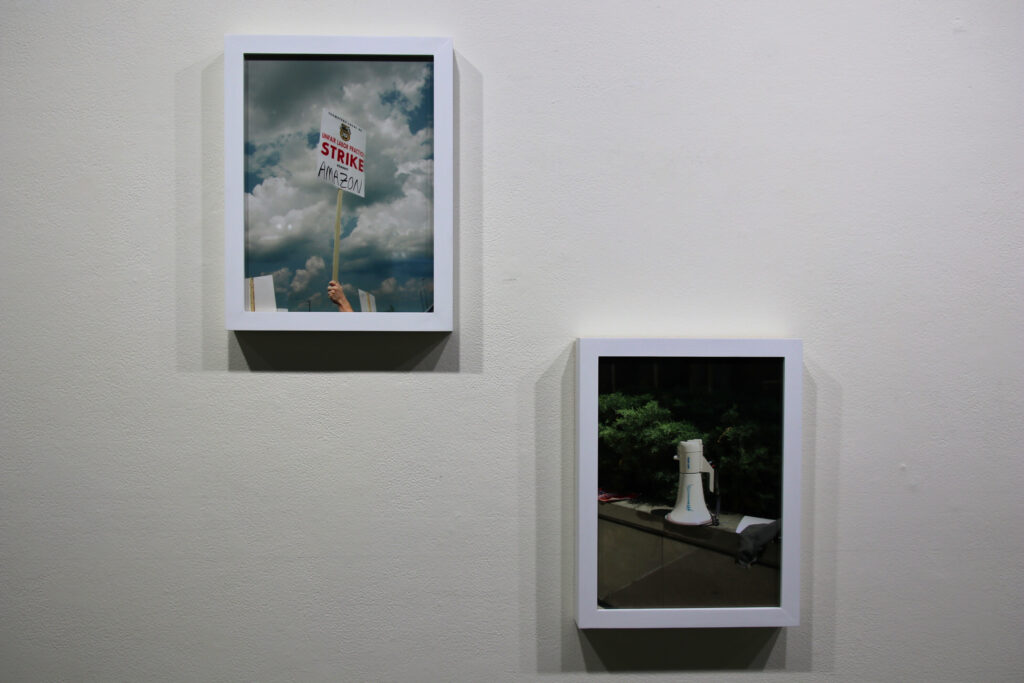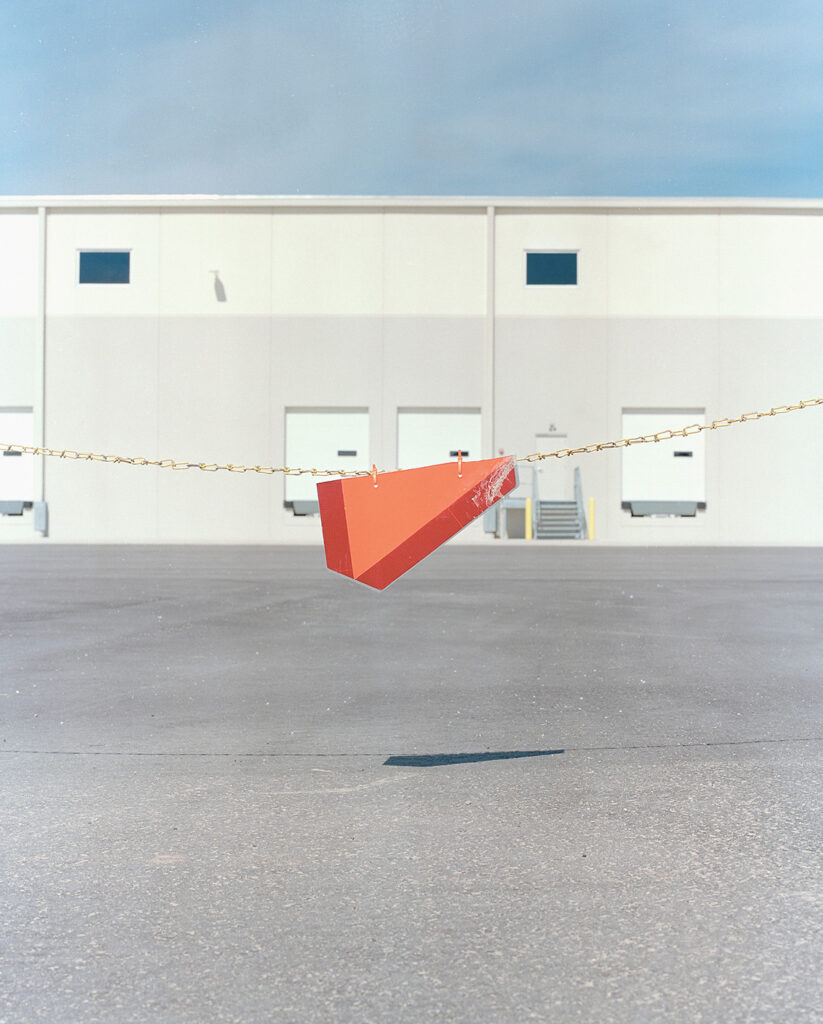Look closer at the sprawling Amazon facilities in Cincinnati and Northern Kentucky and you’ll find more than meets the eye.
That’s what photographers and Art Academy alumni Taylor Dorrell and Cody Perkins invite you to do with Contested Ground, a photo exhibition that centers the spaces and people who influence, and are influenced by, those sprawling facilities. The exhibition is now on view as part of the 2024 FotoFocus Biennial: backstories in McClure Gallery at the Art Academy.
By their own description, Contested Ground “mixes the economic, spatial, and class dynamics of the Amazon boom, while employees in the Northern Kentucky facility seek union recognition and a fair contract.” This series of color photos pulls focus towards the transformative impact large corporate entities have on the land, the people, and the future of communities where they operate.
Taylor and Cody reveal more perspectives, below, about the perspective of Contested Ground.

AAC: How did this opportunity to tell these stories come about? How long have you been engaging with this material?
TD: A lot of my writing and photographic work has focused on labor and geography, specifically how space is shaped by economic forces. I’ve been reporting on labor stories as a journalist for years now (while I also organize with the National Writers Union) and have been writing a lot about the forces changing the material conditions of Columbus. I was following the efforts to unionize the KCVG Amazon facility after the successful unionization of Amazon’s JFK8 facility and wanted to examine how all these forces intersect.
CP: Personally, I have had a lasting interest in the general subject of the change in the economic and literal landscape of the area for at least the last 10 years. Many friends and family members are directly involved/affected by these types of corporations and how their supply chains are managed.
AAC: Tell us about your documentation methods. Where did you begin, and how did you discern what to capture?
TD: Cody had been living around the area throughout his life, so we’d drive around the area with a rough checklist of spots we wanted to photograph like new developments or warehouses. We were interested in spaces that were changing due to nearby Amazon facilities. The photos of union actions were obviously up to wherever they were organizing.
AAC: You’ve written that “economic investments are often relegated to abstract numbers and historical parallels.” Tell us how your documentation grounds viewers in concrete realities, as opposed to ambiguities and echoes of the past.
TD: I’m a fan of presenting photographs that might seem like mundane landscapes but then having a statement that charges the photographs with meaning, especially political meaning. I think a lot about a photo book by Tod Papageorge that shows scenes from different sports games in 1970. The title of the book is American Sports, 1970: Or How We Spent the War in Vietnam. I love this bait and switch, taking an object that anyone would find beautiful and injecting it with an earnestness that strips away its innocence.

AAC: Why do you feel these are important stories to tell and portraits to capture?
CP: Corporate entities have always been known to influence change in communities but being able to show the normal people that are a part of what is going on, day in and day out, is necessary. The people are the ones that are the backbone for these industries and should be treated as such.
AAC: As alumni of the Art Academy, can you tell us how it feels to return, with your professional work, to campus?
TD: It’s exciting to come back and remember that energy. When you graduate and are spending all of your time in the “workforce,” even if it’s in a creative field, you don’t have that consistently stimulating atmosphere. But it also feels good to come back with almost a decade of growth as an artist.
CP: It was fun to reminisce a bit but also exciting to see many of the changes that have occurred since graduating. Overall, it’s been a pleasure to show and collaborate within the space at the Art Academy and refreshing to be around so many creatives!
Read Taylor and Cody’s complete artist statement for Contested Ground. The exhibition is on view in McClure Gallery at AAC until Oct. 25.
Artist & Gallery Info
Taylor Dorrell earned a BFA in photography from the Art Academy of Cincinnati in 2017. Taylor is a freelance writer and photographer, contributing writer at the Cleveland Review of Books, reporter at the Columbus Free Press, columnist at Matter News, and organizer in the Freelance Solidarity Project union. www.taylordorrell.com
Cody Perkins was born in Kentucky in 1995. He went on to study photography and received his BFA from the Art Academy of Cincinnati in 2018. Perkins has exhibited his work in the US and abroad, including work in shows at Praxis Gallery in Minneapolis, at Unseen Gallery in Amsterdam, and at the Alice F. and Harris K. Weston Art Gallery in Cincinnati. Perkins currently lives and works in the Greater Cincinnati area. www.codyperkins.net
Our galleries are free and open to the public, and no registration is needed. Check-in at the security desk is required. View all upcoming exhibitions for the rest of the season.
Gallery Hours
Monday – Friday: 9 a.m. to 9 p.m.
Saturday – Sunday: 9 a.m. to 5 p.m.
Location
Art Academy of Cincinnati College of Art & Design
1212 Jackson St., Cincinnati, OH 45202
Traveling via the Connector streetcar? We’re right around the corner from station 7 in Over-the-Rhine!

